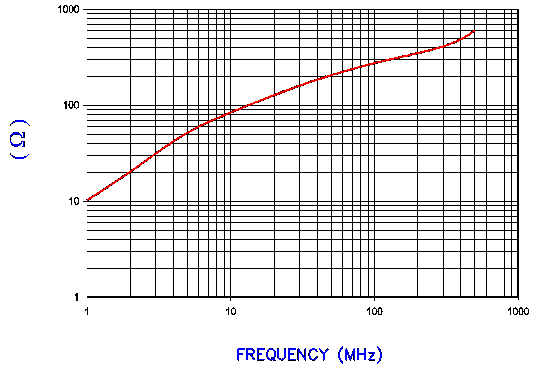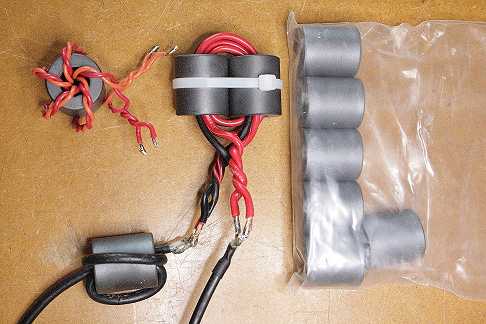
Impedantce curve of one Laird 28B1020-100 mix28 core put on a straight wire.

Impedantce curve of one Laird 28B1020-100 mix28 core put on a straight wire.
Laird 28B1020-100 (Mauser) ferrite cores are successfully used in output matching transformers in 600W short-wave RF power amplifiers http://www.w6pql.com/hf/amp-assembly.htm . It is made of #28 material and meant for wide band noise suppression. At 3.5MHz Z=26 Ohms.
Experiments :
1. A resonance test (parallel circuit with a coil of 1 to 5 turns and 100pF parallel capacitor) failed completely. Between 1.5 and 30MHz no
resonance could be detected with a GDO.
2. A 1 : 1 transformer made with separated primary and secondary windings failed too. At 1.7 MHz the VSWR was 1:1.5, rising fast towards higher frequencies. This MIX28 ferrite material cannot magnetically transfer energy above 1MHz.

De twee geteste trafos en (beneden) een mantelstromen smoorspoel.
3 (top left). A transmission line transformer, wound on one core with firmly twisted primary and secondary
wires, going 5 times through the hole, performed very well. Orange = pri, red=sec. At 3.5MHz Zpri an Zsec are abt. 900 Ohms.
SWR read on the TS570D was 1:1.0 between 1.71 MHz and 14.5MHz. Above that the SWR slowly became higher. With 100W power nearly only a little warming up was noticed after a few
minutes.
4 (top mid). This transformer was wound through two ferrite cores, using thicker twin loudspeaker cable.
The cable ran in parallel (NON twisted) three times trough the holes. At 3.5MHz Zpri and Zsec are abt. 650 Ohms.
It performed very well to : SWR between 1.71MHz and 15MHz 1:1.0. Above that the SWR slowly became higher.
In order to keep SWR above 15MHz as low as possible, it proved to be important to twist the wire ends.
Warning.
You have to be aware that between the tightly coupled primary and secondary
windings also capacitive coupling exists. That is not always acceptable.
For instance : capacitive coupling at my magnetic loop antenna had a bad
influence on its wanted good properties.
Maximal current.
According to a manufacturer, a 3 core mains power cable (3x0.75mm2) can handle up to 1300W at 230V~. The max. current is
therefore 5.65A. Max current density then is 7A/mm2. With
50Ohms load the max power for only 0.75mm2 can be calculated as 1.6kW. Beside
that, the extra temperature rise, due to the lack of air cooling inside the
ferrite core, has to be taken in account.
Heath losses in ferrite cores.
Some ferrite properties:
MIX28 : Ui=650, loss factor 500, Tc >= 140C.
MIX61 : Ui=125, loss factor 30, Tc >= 350C.
At material temperature above its Tc (Curie temp), a core looses its electrical properties.
The two-core MIX28 transformer above, was tested on 1.71MHz and 14.350MHz with 100W continues power. Temperatures were measured using a infrared thermometer. After 5 minutes a 50W dummy load became very hot (80C), proving power was effectively transported. Ferrite core temperatures raised only 15C.
If 5min. 400W RTTY should be used, the core temp should rise from 23C to 83C. To hot to tough, but acceptable as no damage to the materials are expected. The wire insulation must also be able to withstand these temperatures.